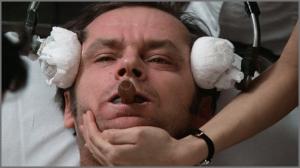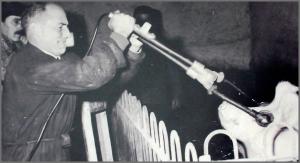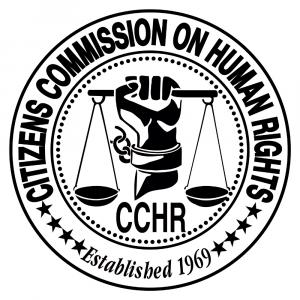Involuntary Psychiatric Treatments: Documentary Raises Human Rights Group's Concerns About Electroshock

Actor Jack Nicholson in the popular classic film "One Flew Over the Cuckoo's Nest" which depicted involuntary electroshock treatment. Many thought that electroshock was banned after this film. It was not.
“Therapy or Torture: The Truth about Electroshock” documents that involuntary electroshock is a human rights abuse. So why is it still in use today?
However, some, including the Citizens Commission on Human Rights (CCHR), contend that ECT is torture, causes brain damage and is a human rights abuse. The gripping documentary, “Therapy or Torture: The Truth about Electroshock,” by CCHR, reveals alarming facts about the $5.4 billion ECT industry.
Electroshock shoots up to 460 volts of raw electricity through brain tissue to induce a grand mal seizure, the most serious form of seizure, lasting up to 30 minutes. Hospital emergency room doctors treat grand mal seizures as a medical emergency. Psychiatrists call it “therapy.”
Even long-term shock doctors don’t know how much voltage it will take to produce a seizure in a patient. To put that voltage in context, a human brain is normally powered by a mere 0.2 of a volt of electricity – that’s eight times less electricity than a watch battery.
Psychiatrists admit they don’t know how ECT “works.” They don’t study the underlying science because there isn’t any. It’s trial and error with human lives.
According to the U.S. Food and Drug Administration (FDA), electroshock can cause brain damage, cognitive impairment, permanent memory loss, prolonged or persistent seizures, worsening psychiatric symptoms, cardiovascular complications (including heart attacks), breathing complications, and death.
As psychiatrist Max Fink, M.D., considered the grandfather of electroshock in the U.S., coldly admitted: “The principal complications of ECT are death, brain damage, memory impairment and spontaneous seizures.”
Psychiatrists performing electroshock can live with that damage – and very profitably. It is estimated that a psychiatrist doing as few as 20 ECT sessions a week can bring in an additional $300,000 per year.
Most damning of all is the lack of scientific evidence behind it. Because the machines were grandfathered in when the FDA was first given authority to regulate medical devices, the manufacturers were never required to prove that electroshock machines and procedures are either safe or effective. CCHR believes the FDA relied upon biased studies to reduce the risk classification of the ECT device in its Final Rule in December 2018 to make electroshock widely available. It says that the studies were a conflict of interest based on a biased, false premise that electroshock is “safe and effective,” despite not a single clinical trial submitted by the ECT manufacturers supporting this. CCHR wants Congress to investigate the FDA’s reliance upon these studies and the potential failure to demand all study data showing long term risk. The most recent federal judge’s decision has reinforced CCHR’s resolve.
The investigation should include how those aged five and younger and frail elderly are being electroshocked when no clinical trials support this, CCHR says. Research shows that senior citizens who received ECT died at over six times the rate of those who did not undergo it.
CCHR maintains that psychiatry’s coercive practice of performing brain-damaging electroshock on emotionally vulnerable patients against their will is a cruel and degrading human rights violation that must be outlawed.
In a 2013 United Nations Human Rights Council report by then UN Special Rapporteur on Torture and Other Cruel, Inhuman and Degrading Treatment or Punishment Juan E. Méndez agrees.
His report analyzed torture and mistreatment commonly justified as health care treatment, and in its conclusions, called for “an absolute ban on all forced and non-consensual medical interventions against persons with disabilities, including the non-consensual administration of psychosurgery, electroshock and mind-altering drugs….”
A 2018 U.N. Human Rights Council report also called on governments to recognize forced psychiatric treatment, including electroshock, as “practices constituting torture or other cruel, inhuman or degrading treatment or punishment….”
The documentary can be viewed in full on demand on Scientology TV: https://www.scientology.tv/series/cchr-documentaries/therapy-or-torture-the-truth-about-electroshock.html
Since 1969, CCHR has helped obtain more than 180 laws that protect mental health patients, including laws requiring informed consent for ECT and laws prohibiting it for minors in some states. CCHR has posted an online petition, with over 122,000 signers supporting a complete ban on electroshock.
The Citizens Commission on Human Rights National Office in Washington, DC, has advocated for mental health rights at the state and federal level. The CCHR traveling exhibit has been displayed in Washington, DC, at the Congressional Black Caucus Foundation Annual Legislative Caucus, as well as other locations. The exhibit has toured more than 441 major cities around the world and has educated over 800,000 people on the history and contemporary practices of psychiatry which are still rampant with abuse.
About Citizens Commission on Human Rights: CCHR is a nonprofit, non-political, non-religious mental health watchdog. Its mission is to eradicate abuses committed under the guise of mental health and to enact patient and consumer protections. CCHR was co-founded in 1969 by the Church of Scientology and Professor of Psychiatry Emeritus Dr. Thomas Szasz.
Sign CCHR’s petition in support of banning ECT which already has more than 122,000 signatures at www.change.org/p/ban-electroshock-ect-device-being-used-on-children-the-elderly-and-vulnerable-patients.
Anne Goedeke
Citizens Commission on Human Rights, National Office
+1 202-349-9267
email us here
Visit us on social media:
Facebook
Legal Disclaimer:
EIN Presswire provides this news content "as is" without warranty of any kind. We do not accept any responsibility or liability for the accuracy, content, images, videos, licenses, completeness, legality, or reliability of the information contained in this article. If you have any complaints or copyright issues related to this article, kindly contact the author above.


